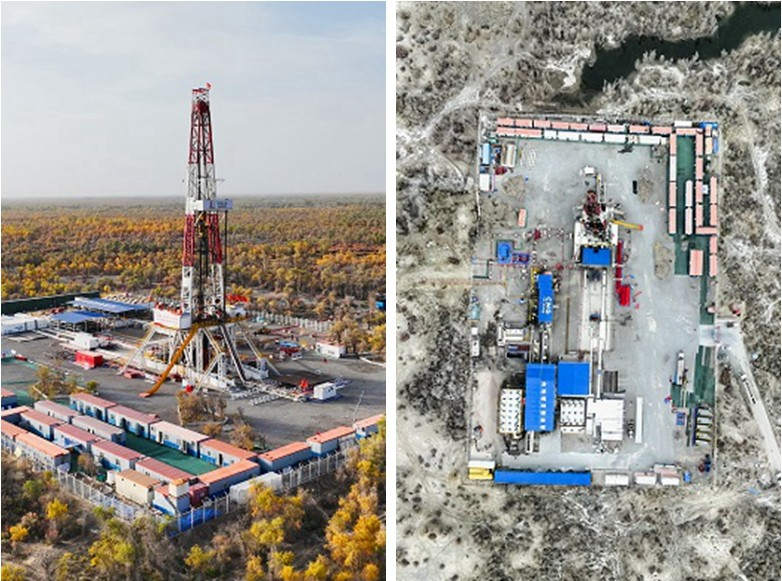In 2024, the export volume of seamless steel pipes in China was 5.7211 million tons,…
Chinese Sinopec’s “Deep Earth No. 1” made a breakthrough in the test of the YJ3-3XC well deployed in the Tarim Basin, achieving a high-yield oil and gas flow with a daily production of 200 tons of crude oil and 50,000 cubic meters of natural gas.

The YJ3-3XC well of the “Deep Earth No. 1” is located in Shaya County, Aksu region, Xinjiang, on the edge of the Taklamakan Desert. It started drilling on May 1st and, after 177 days of construction, completed drilling on October 26th, setting records for the deepest well deviation and super-deep drilling horizontal displacement in Asia. The well reaches a depth of 9,432 meters, surpassing the height of Mount Everest by 584 meters. In addition to facing the challenges of complex geological structures, high temperature, and high pressure associated with super-deep wells, the well also features a horizontal distance of over 3,400 meters, presenting new challenges such as difficult casing placement and the formation of a “cuttings bed” in the horizontal section, making the construction difficulties rare domestically and internationally.
The YJ3-3XC project has pioneered the development of a technology system for rapid drilling in super-deep oil and gas layers, achieving a significant leap from “unable to drill” to “drilling quickly and accurately.” According to reports, the project, led by Sinopec Northwest Oilfield, has brought in outstanding technical teams from both domestic and international sources, fully integrating high-quality resources and advanced technologies. It applied advanced tools such as long-life rotary steering and high-performance drill bits, boldly adopting new processes to solve challenges like rock breaking for speed enhancement. The project also extensively utilized big data and remote support for efficient risk warning, optimizing drilling parameters in real-time, transforming from “experience-based drilling” to “scientific drilling.”
The YJ3-3XC well, located outside the red line of the upstream wetland nature reserve of the Tarim River, extracts oil and gas from a depth of over 7,200 meters beneath the protected area, using innovative super-deep large-displacement technology. To protect the local ecological environment, Northwest Oilfield innovatively applied super-deep large-displacement technology, akin to standing two meters away and drinking soy milk by inserting a straw into a cup and extending it horizontally. After horizontally extending 3,400 meters in the underground formation, rich oil and gas resources were obtained. Simultaneously, in the “deep and dark” underground, accurately finding oil and gas through large displacement horizontal wells required giving the drill bit “eyes.”
Northwest Oilfield utilized super-deep high-temperature efficient directional technology, transmitting signals from depths below 7,000 meters in real-time to the surface using a high-precision down hole measurement and control system. This equipped the drill bit with “eyes,” allowing real-time adjustments to the drill bit’s trajectory, swiftly maneuvering like “Snake” at a depth of 7,200 meters, achieving a leap from short-distance to long-distance horizontal wells and from long cycles to short cycles. In addition to the YJ3-3XC well, two other super-deep large-displacement wells were deployed in the same well site, breaking two Asian records and achieving five industry-leading results. With the breakthrough in the YJ3-3XC well, all three wells have achieved efficient production, accumulating 58,000 tons of crude oil, estimating an additional recoverable reserve of 310,000 tons, providing valuable lessons and guidance for the efficient utilization of oil and gas resources in ecological red line areas, reservoir areas, and similar domestic locations.
Deep oil and gas resource exploration and development are essential components of deep Earth exploration. In recent years, 60% of the world’s newly added oil and gas reserves have come from deep formations. Deep and super-deep formations have also become the main battlefield for major oil and gas discoveries in China, with the country’s deep and super-deep oil and gas resources reaching 671 billion tons of oil equivalent, accounting for 34% of the total national oil and gas resources. Taking the Tarim Basin as an example, oil and gas resources buried at depths of 6,000 to 10,000 meters account for 83.2% and 63.9% of the total, respectively, indicating enormous exploration potential. Through collaborative efforts, Sinopec has made significant breakthroughs in deep oil and gas enrichment theory and exploration and development technology, becoming a major force in China’s deep oil and gas field.
In recent years, Sinopec has actively ventured into the deep Earth, creating the “Deep Earth No. 1” demonstration project. Currently, drilling depths of over 8,000 meters have been achieved in 108 wells at the Shunbei oil and gas field base of the “Deep Earth No. 1,” achieving significant breakthroughs in oil and gas for six consecutive years. Four billion-ton-class oil and gas zones have been identified, with a cumulative production equivalent to over 8 million tons of oil and gas, becoming a new highlight in oil and gas exploration in the Tarim Basin over the past decade.




